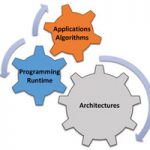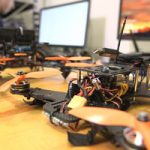Exceptional service in the national interest
Two dates are well known to Sandians: the day President Harry Truman wrote a letter calling for “exceptional service in the national interest” and the day Sandia (previously Z Division) separated from its parent, Los Alamos National Laboratory, and became the entity we know it as today.
AI center to combine hardware, software for practical gains
Sandia and Pacific Northwest national laboratories and the Georgia Institute of Technology in Atlanta are launching a research center that combines hardware and software design and development to improve artificial intelligence technologies that will ultimately benefit the public.
Security in a heartbeat
Sandia is collaborating with a New Mexico small business to test and develop a biometric security system based on the human heartbeat. Sandia signed an agreement with Albuquerque-based Aquila Inc. to develop and test a wearable prototype that can stream in real time an identifying signature based on the electrical activity of a person’s heart.
Engineering success through predicting failure
Around the world, materials scientists and engineers are trying different ways to predict fractures in ductile metals, but it’s not clear which approach is most accurate. To compare the different methods, Sandia researchers have presented three voluntary challenges to their colleagues: Given the same basic information about the shape, composition and loading of a metal part, could they predict how it would eventually fracture?
Lowering the bar for hydrogen-powered technology
The Hydrogen Materials Advanced Research Consortium, or HyMARC, a multilab collaboration co-led by Sandia, is developing two types of hydrogen storage materials to meet challenging energy density targets set forth by DOE. The newly expanded collaboration is using the most promising strategies to optimize the materials for future use in vehicles.
Armoring satellites to survive, operate through attacks
Researchers at Sandia launched a seven-year mission campaign this month to develop the science, technology and architecture needed for autonomous satellite protection systems. The campaign, called STARCS, will fund dozens of Laboratory Directed Research and Development projects.
MESA fabs get an upgrade
Sandia has completed phase one of an anticipated three-year upgrade at its plant responsible for making integrated circuits, similar to computer chips. The facility is now fully compatible with industry-standard, 8-inch silicon wafers — thin, round starting materials used for making chips.
Autonomy New Mexico interns build drones to test hypersonic tech
Sandia is developing autonomy and artificial intelligence for flight systems soaring at more than 3,800 mph. The technologies to get there will initially be tested on drones that shuffle around at about 5 mph.
Hispanics and STEM education at Sandia
The population of Hispanics/Latinos in the U.S. is expected to grow by approximately 40% by 2045, although only approximately 14.4% have bachelor’s degrees or higher and 7% are employed in STEM industries. Presently at Sandia, Hispanics and other minorities make up a significant 34% of the overall workforce. That number is expected to increase, thus promoting diversity at our sites.
American Indian Science and Engineering Society recognizes early-career Sandian
Geoscience engineer Dylan Moriarty has been named the 2019 Most Promising Engineer or Scientist by the American Indian Science and Engineering Society. The award is given to an American Indian, Alaska Native, Native Hawaiian, Pacific Islander, First Nations or other indigenous person of North America with less than five years of work experience since his or her last degree.









